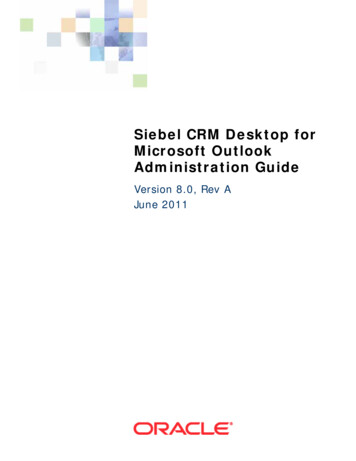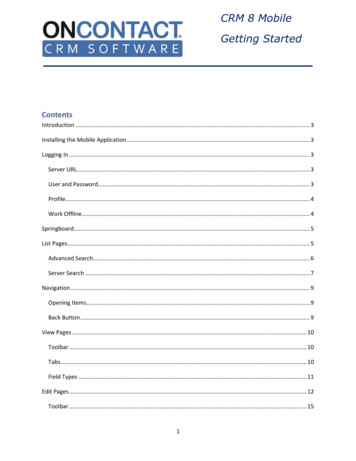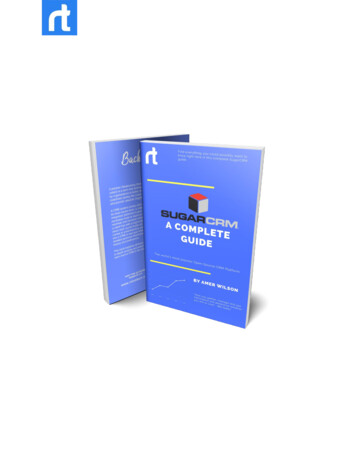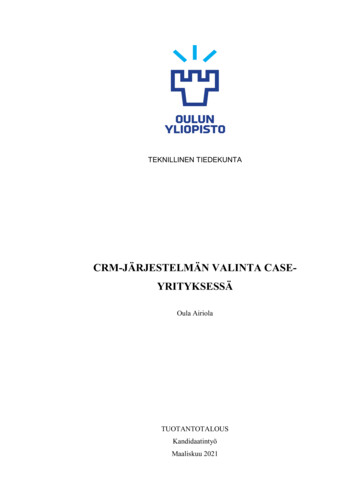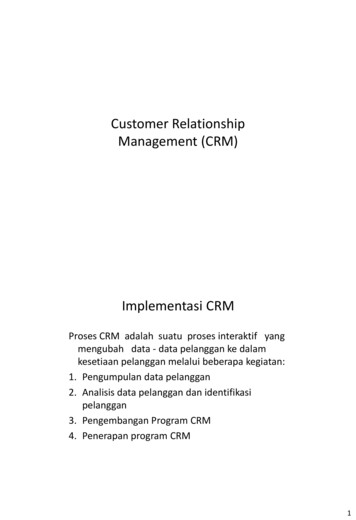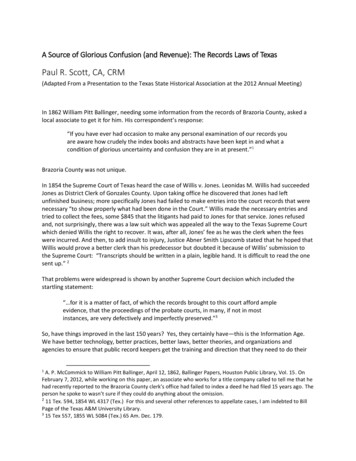
Transcription
A Source of Glorious Confusion (and Revenue): The Records Laws of TexasPaul R. Scott, CA, CRM(Adapted From a Presentation to the Texas State Historical Association at the 2012 Annual Meeting)In 1862 William Pitt Ballinger, needing some information from the records of Brazoria County, asked alocal associate to get it for him. His correspondent’s response:“If you have ever had occasion to make any personal examination of our records youare aware how crudely the index books and abstracts have been kept in and what acondition of glorious uncertainty and confusion they are in at present.”1Brazoria County was not unique.In 1854 the Supreme Court of Texas heard the case of Willis v. Jones. Leonidas M. Willis had succeededJones as District Clerk of Gonzales County. Upon taking office he discovered that Jones had leftunfinished business; more specifically Jones had failed to make entries into the court records that werenecessary “to show properly what had been done in the Court.” Willis made the necessary entries andtried to collect the fees, some 845 that the litigants had paid to Jones for that service. Jones refusedand, not surprisingly, there was a law suit which was appealed all the way to the Texas Supreme Courtwhich denied Willis the right to recover. It was, after all, Jones’ fee as he was the clerk when the feeswere incurred. And then, to add insult to injury, Justice Abner Smith Lipscomb stated that he hoped thatWillis would prove a better clerk than his predecessor but doubted it because of Willis’ submission tothe Supreme Court: “Transcripts should be written in a plain, legible hand. It is difficult to read the onesent up.” 2That problems were widespread is shown by another Supreme Court decision which included thestartling statement:“ for it is a matter of fact, of which the records brought to this court afford ampleevidence, that the proceedings of the probate courts, in many, if not in mostinstances, are very defectively and imperfectly preserved.”3So, have things improved in the last 150 years? Yes, they certainly have—this is the Information Age.We have better technology, better practices, better laws, better theories, and organizations andagencies to ensure that public record keepers get the training and direction that they need to do their1A. P. McCommick to William Pitt Ballinger, April 12, 1862, Ballinger Papers, Houston Public Library, Vol. 15. OnFebruary 7, 2012, while working on this paper, an associate who works for a title company called to tell me that hehad recently reported to the Brazoria County clerk’s office had failed to index a deed he had filed 15 years ago. Theperson he spoke to wasn’t sure if they could do anything about the omission.211 Tex. 594, 1854 WL 4317 (Tex.) For this and several other references to appellate cases, I am indebted to BillPage of the Texas A&M University Library.315 Tex 557, 1855 WL 5084 (Tex.) 65 Am. Dec. 179.
jobs well. And we no longer depend on idiosyncratic communications and court cases to document thecondition of our public records; we now have trained professionals and formal taskforces for the job.In August 2011 The Texas Court Records Preservation Task Force reported:“In many instances, counties are adequately preserving their Records. In otherinstances, however, counties throughout the State need substantial help. ManyRecords are decaying or being destroyed due to an influence of events andconditions, including (i) improper storage and handling, (ii) the effects of moistureand temperature fluctuations, (iii) the ravages of rats, bugs, and vermin; and (iv)the acidity of the ink and the poor quality of the paper.”4There we have it, those things that historians love—change and persistence. We have resources andtechniques that would dazzle clerks of yore, but yet we continue to lose historically-significant recordsto the ravages of time and neglect.Why is this? Now, as then, the problem most often cited it is a lack of resources, or, to put simply,money. But is it? The reality seems to be that all too often records are appreciated more for theirrevenue generating potential than for their informational value.From the beginning custodians of public records have collected money intended to pay for the creationand preservation of records, and from the beginning there have been other demands—often morepressing than spending resources on records that that would wait a little while longer—probably as longas the next administration.Throughout the 19th and early 20th Centuries county and some other officials were compensated underthe fee system. Succinctly, county clerks, district clerks, and other county office holders collected feesfor each service they performed and from this income they paid salaries and—the evidence indicates—often met the other expenses of office. Tax dollars did pay for their offices and furnishings in thecourthouse and frequently the statutes specified that the county was to purchase the books andstationery required. But evidence indicates that the fees of office were often expected to cover theexpenses of office.The statute creating justice courts, for example, stated that “every justice of the peace shall make a fairrecord in a book that he shall keep for that purpose, of the proceedings in all suits and examinations hadbefore him.”5 That the justice was responsible for procuring his own books is evidenced by the fact thata number of 19th Century JP records at the Harris County Archives were used for other purposes bothbefore and after they served as justice records—including business journals, notarial registers, and theCity of Houston financial ledger for 1840-1853.The first law, I found indicating that it might be the duty of the Commissioners to provide books andstationery was in 1846, and it was surpassingly vague. It provided:4The Texas Court Records Preservation Task Force, Report on the Preservation of Historical Texas State CourtRecords, August 31, 2011, p. 1. Hereafter cited as TCRPTF.5Gammel, Vol. 1 p. 1203.
“That the clerks of the county courts of the several counties of this State shall be therecorders for their respective counties: they shall provide and keep in their officeswell bound books, in which they shall record all instruments of writing authorizedor required .”But another section provided that:“Each recorder shall provide suitable books and presses for his office, and shall keepregular and faithful accounts of the expenses thereof, and such accounts shall beaudited by the county court and paid out of the county treasury.” 6Shortly afterward the Legislature was much clearer about the counties’ responsibilities for court records:“each county court shall cause a record to be kept of all its proceedings, in suitable books for thatpurpose, to be procured at the expense of the county. ”7The actions of the Burleson County commissioners in 1846 and 1847 give credence that the county wasproviding clerks with books and stationery. At that time the County was deep in debt and had issuedwarrants, or script, in payment to its creditors—mostly county residents. These IOU’s were receivablefor taxes, fees and fines due the county but had no value to stationers providing books, forms and othersupplies to the clerks. The commissioners, thus, decreed that a portion of the county tax (varying from athird to a fifth) had to be paid in hard money which was to be used to purchase stationery needed bythe clerks.8While Commissioner Court Minutes and Minutes of Accounts Allowed after 1845 indicate that what wewould call the general fund being used to purchase supplies, the very fact that the statutes sometimesspecified that was a county expense and sometimes didn’t, indicates that the commissioners may nothave always picked up the record-keeping tab.However the early books were procured, many must have been shoddy indeed because Congress andthen the Legislature repeatedly passed bills authorizing county and district clerks and surveyors ofnumerous counties to transcribe the early volumes. The cost was borne by the county treasury, typicallyat 10 to 15 per 100 words.9 The legislature passed so many county laws authorizing the transcriptionof records that in 1870 it finally passed a general act permitting county records to be transcribedwhenever they were “defaced, worn, or in any condition endangering their preservation.”10While the early statutes required that officials keep records, they provided little guidance as to form orquality of material. The laws of Coahuila and Texas specified “bound” books and in 1837 the Republicupped the standard to a “well bound book,” a phrase that persevered into the 20th Century and whichmeaning was twisted to include microfilm on reels and cartridges.116Gammel, Vol. 2, p. 1542. It should also be noted that court clerks collected fees from litigants payable to otherofficials. The audit requirement may have also been meant to protect the interest of the others.7Gammel, Vol. 2, p. 1643. See Also Gammel, Vol. 3, p. 302 for the 1848 statute. Vol. 5, p. 1149 for 1866. By 1870the law required commissioners court to provide books and stationery for the JP’s. Gammel, vol. 6, p. 285.8Commissioner Court Minutes, Burleson County, October Term 1846 and July Term 1847, no page number.9Gammel, too many to note fully but see Vol. 2, p. 1597 for Brazoria County (1846); Vol. 3. P. 15 for Red RiverCounty, 1848; Vol. 3, p. 511 for Red River (again), 1850;10Gammel, Vol. 6, p. 285.11Gammel, Vo. 1, p. 360 & 1294.
By 1866 the Legislature momentarily got serious –very serious—about quality. It specified “a well boundrecord book, of good quality containing at least eight quires of paper.” On top of that, the lawprovided that the State would pay for these books. And what were these records that the Legislaturecared so much about? Well, the Tax Roll, of course, a copy of which went to Austin so that the Statecould make sure it got its due share. 12While we’re on the subject of money, I guess I should say something about the fees. The problem withthat is that each office had its own fee structure and Congress and the Legislature frequently rewrotethe laws. Fees were charged by the clerks of all courts from the county clerk to the supreme court, byjustices of the peace, sheriffs, constables, surveyors, district attorney, and other officials. Thus, thissubject can quickly grow tedious. But a few examples may be in order:To issue a marriage license: 1.For a writ, 50 .Docketing a case, 15 .Copy of a petition, 15 per 100 wordsFiling and recording each deed, 15 per 100 words.Surveying a tract of land 2 an English mile.13As shocking as it sounds, some officials were more concerned with their fees than performing a publicservice. Indeed, right here in Harris County, Chief Justice Andrew Briscoe wrote to President Lamarcomplaining of District Attorney A. M. Tomkins who held “the most profitable office in the nation.”Briscoe claimed that the prosecutor “has too many necessities for money to be always honest in thedischarge of his official duties.” One specific complaint was that “he has entered a nolle prosequi onmany indictments by the Grand Jury of this county, on the defendant’s confessing Judgment for costs, sothat he could get his fee as on a successful prosecution.” 14Briscoe also had some harsh things to say about Tomkins’ character and habits. Nevertheless, holdingpublic office was usually a part-time job and officials typically pursued other interests. In Tomkins’ case,for instance, even while he was a prosecutor he continued his private legal practice and among otherthings, defended in city court a number of free blacks charged as being in Texas unlawfully.Nevertheless, being a public official could be profitable, and that would help to explain why officialssometimes demonstrated a proprietary interest in their records. An extreme example of this was a claimHarvey Mitchell of Brazos County submitted to the State Comptroller with an attachment which read:12Gammel, vol. 5, p. 1064. (NOTE: As time permits, check the earlier statutes for assessment and collection oftaxes to ascertain if they include similar provisions.)13Gammel, Vol. 1, p. 1294, Vol. 2, pp. 719-720.14Lamar Papers, pp. 450-451. County officials were not alone in valuing fees more than justice. In1861 Lt. EdwardIngraham, of the 1st Regular Confederate Cavalry wrote that local authorities in San Antonio “commenced puttingmy men in jail to collect fees and make a fund off therm.” One man was actually innocent, but the authoritiesinsisted on a substantial fine before releasing him. Ingraham refused reporting “ I informed them I would pay thefine of no soldier under any circumstances whatever; that the police only took them for speculation and I’d be noparty to any such nefarious proceedings, that they might keep him in jail for the period prescribed by law, but if hewas compelled to do one particle of work there, I would sue the city.” Quoted in Richard B. McCaslin “United StateRegulars in Gray: Edward Ingraham and Company A, 1st Regular Confederate Cavalry,” Southwestern HistoricalQuarterly Vol. CXVIII No. 1, July 2014, p. 38.
“Know all men by these presents that I James D. OVERTON formerly Clerk of TheDistrict Court for Brazos County for a valuable consideration to me in hand paid by H.MITCHELL of the State of Texas & County of Brazos have this day sold and by thesepresents do assign all my right title interest and claim in and to the Books in the officeof the said District Court, of said Brazos County, together with all and singular the feesand [illegible] therein charged, both in civil and criminal cases tried or institutedduring the period of my service as said District Clerk. In testimony whereof Iherewith sign my hand and seal for seal this 13th day of July 1850. J.D. OVERTON. “15The problem of outgoing officials failing to turn over the records and properties belonging to the officemust have been common because in December 1836 Congress passed the bill organizing the SupremeCourt; it included the following provision:“The successor in office of any clerk shall receive into his possession, all papers, books,stationary (sic), and everything belonging to the said office; and should the person orpersons having possession of the same refuse to give them up on demand made, itshall be the duty of the clerk to give information thereof to the attorney general, whoshall prosecute such person or persons in the name of the republic .[and] the personso offending shall be fined in the sum of ten thousand dollars, for the use of therepublic.”16Similar laws were passed for other offices, but even today in every election cycle we seem to read ofsome newly elected official taking office and finding that his predecessor had removed all the records ofthe office. Consequently, the current law for local government records now reads:“RECORDS TO BE DELIVERED TO SUCCESSOR IN OFFICE. (a) A custodian of localgovernment records shall, at the expiration of the custodian’s term of office,appointment, or employment, deliver to the custodian’s successor, if there is one, alllocal government records in custody. If there is no successor, the governing body shalldetermine which officer of the local government shall have custody.”17That early Texans disapproved of culprits stealing, defacing, or falsifying official records is demonstratedby the law approved on December 21, 1836 that provided that the penalty for such offenses was a finenot to exceed 1,000 and—at the discretion of the court—50 lashes on the bare back.18 By 1858 Texashad become a more civilized state and the new criminal code no longer provided for flogging suchmiscreants but provided for prison sentences ranging from 2 to 7 years.19Except for actual criminal acts, the early law, as far as I can tell, provided no recourse for dealing withfailings of public officials except (1) that wronged individuals could bring suit against the official and his15Audited Claims, Texas State Archives. For this I am indebted to Bill Page at the Texas A&M University Library.Among the strange things about this claim is that Mitchell did not succeed Overton as the district clerk—Mitchellserved as County Clerk.16Gammel, Vol. 1, p. 1142.17Local Government Code 201.005.18Gammel, Vol. 1, p. 1251.19Gammel, Vol. 4, pp. 1033 & 1053.
bondsmen and (2) by voting them out of office at the next election—and sometimes even that was notan option.Illustrating this is an episode in Trinity County in 1867 when the military was relieving serving officialsand appointing new ones left-and-right. When the office of county clerk became vacant there was noone suitable who could take the ironclad oath. The closest the county judge could come up with wasWilliam L. Culbreath “the only man with us who could take the oath” as he had not participated in theRebellion—he was, in fact, a veteran of the War of 1812—over 50 years before. He was well respectedin the community and was acceptable to the authorities, but he had problems: he was hard of hearingand could not communicate well with his associates, which was actually only a minor inconvenience ashe quickly forgot most of what he heard anyway probably because of what we now call Alzheimer’s.But a mental disability was no bar to public office, so the county judge decided to nominate the old manand found men of property to go his bond, with one condition—that Culbreath deputize Z. Norton toperform the duties of office. That worked out well enough until the deputy decided to return to Georgiaat which point the bondsmen withdrew their bonds being unwilling to subject themselves to thefinancial hazards of guaranteeing the old man’s performance in office. 20As Texas grew and developed during the late 19th and early 20th Centuries record keeping did not changeall that much. Typewriters and adding machines replaced pens and iron gall ink and stationers providedbetter and better well bound books, including some designed for typewritten pages, but clerks stilltranscribed documents word-by-word.Joseph Allen Myers, County Clerk of Brazos County from 1886 to 1890 wrote:“I tried hard to make one of the best Clerks that the County had ever had. I worked from5 AM to 8 PM nearly every day. I have recorded as many as twenty-five deeds in a daybut that took work and tested the strength of my poor old crippled right hand.” 21There were no guidelines as to what records and documents could be discarded so the volume grew andgrew until unused records were stored wherever the county had unused space. And, the recordssuffered. I once found a volume of Probate Minutes for 1846-1851 that had the following inscription:“These old books are very valuable and historic relics. They ought to be rebound & securelylocked in a vault.“These are originals. I hope the commissioners court some day will look after these old landmarks of our fathers. The courts pay no attention to me.“They were junked when I found them 1929.J. J. Faulk“They were still junked 10 years later. May 25th 1939.20B. F. Harper to James W. Throckmorton, July 4, 1867, 301-55, Folder 26; Z. Norton to J. W. Throckmorton, May 7,1867, 301-54 Folder 21; B. F. Harper to E. M. Pease, August 10, 1868 Folder 43, Governors Papers, Texas StateArchives.21Joseph Allen Myers, “Life of Joseph Allen Myers Written in the Month of November 1927,” William Allen Myers(ed.) , p. 29. unpublished manuscript. Bryan Public Library.
J. M. Boulding“They are still junk in 194[?]John L. Chambers”22By 1897 the fee system of compensating officials was falling out of favor because the compensation ofofficials in the larger counties was often “out of all proportion to the value of the services rendered, andto the compensation received by the great majority of officers in the state, including the highest .” Inconsequence, the legislature passed a new fee bill limiting the amount officials in the larger countiescould retain.23 An added impetus came in 1913 when newly-appointed Harris County Auditor HarryWashburn brought the first of 25 suits against county officials who had failed to remit the county’s shareof money they had collected. These suits brought in 500,000—the equivalent to some 10,750,000today. The Depression was another factor and in 1936 the legislature made the fee system of officialcompensation optional. Counties were given the choice of retaining the current fee system or keepingall the fees collected by the elected officials and paying them a set salary.Need I say which option prevailed?Today Texas local officials still collect even more fees than their predecessors as the Legislature is fondof funding desirable initiatives by imposing fees on court cases—especially criminal cases.The fees that concern us here are the ones for the preservation, management, and automation ofrecords. The Texas State Library and Archives initially proposed fees in the 1980s to fund its local recordsprogram. The county and district clerks rebuffed the Library, but in 1991 the county clerks securedpassage of SB 770 providing them with a 5 Records Management and Preservation Fee. In 1993 thedistrict clerks and county commissioners each got bills filed on their behalf with the outcome being SB1058 which provided designated fees for the county and district clerks and for the county-wide recordsmanagement program with commissioners court having oversight.Things have blossomed since then and now Harris County’s accounting system tracks recordspreservation fees in three different funds with a total of 10 object codes. For 2011, Harris Countyprojected its collections at 5,549,453. We have 16% of the state’s population and, according to theTexas Judicial Council, account for 16% of all civil and criminal cases filed in county and district courtsduring FY 2009-2010. Assuming that all other counties are as conscientious as we are in Harris Countyabout collecting the fees and that Harris County is a sufficient sample that translates to well over 34,000,000 state wide. 2422Published in The Local Record Spring 1988. (I do not recall what county this was.)35 Tex. Civ. App. 421, 80 S. W. 656; Gammel, Vol. 10, pp. 1445-1453 & Vol. 11, p. 25. The 1897 Fee Bill limitedcounty clerks of the most populous counties to 2,500 plus ¼ of fees collected in excess of 2,500 after payment ofdeputies and office expenses.24Harris County Auditor’s Office, Final Estimate of Available Resources, Fiscal Year 2012. This report is available tocounty employees on the Auditor’s Intranet but not to the general public except by request; Statistics for types ofcases filed by each county in Texas is available from the Texas Judicial Council athttp://www.txcourts.gov/statistics.aspx. Accessed on January 27, 2012. Municipal courts can also collect a recordsmanagement fee, but I have no estimate of those collections. They will be a pittance compared to the counties.23
And this is just for money earmarked for records management and preservation. It does not includemoney the clerks collect for other purposes. But the bottom line is that public records generate vastamounts of money.And how is this money used? The short answer is just about any way that the records custodians andcommissioners court can agree on, or in some cases, get by with.25 The Supreme Court’s task forcemakes the point that there is no state-wide reporting system for the collection and use of recordsmanagement and preservation fees. 26Some counties spend large sums for records preservation hiring companies to clean, repair, de-acidify,image, and encapsulate case files and bound volumes. 27 Others upgrade HVAC and security systems,and others hire records managers and establish records centers with their funds. The Attorney General,however, has ruled that the funds may not be used to purchase archival documents or to pay any part ofa salary that is not associated with records management and preservation.28Enough about filthy lucre: let’s get back to the records themselves.After World War II record keeping practices began to change because of the volume of business andtechnology. Between 1905 and 1911 the Harris County Clerk averaged 10,000 deeds a year but by 2006the number had risen to over 855,000.29 Clearly, the old system had to be replaced and after World WarII, microfilm became a recording media.The Legislature, presumably at the request of the clerks, responded to this new process by enacting lawsfor various county offices authorizing and regulating microfilm.30 By 1973 when I started working as afield archivist for the Texas State Library and Archives Commission, there were three differentmicrofilming laws—one for the county clerk, another for the district clerk, and the third for everyoneelse; they were not uniform—but they were onerous.The legislators had gone a bit overboard and they wrote into laws detailed procedures that includedtargets before and after the documents being filmed. One of these documents was the cameraoperator’s certificate of authenticity. I cannot vouch for this, personally, but the late Sam Sizer (one ofmy more interesting former supervisors) maintained that the original wording in the law required thisdocument to be “singed” by the camera operator. Perhaps, but I never saw any charred certificates, onlysigned ones.25Attorney General Opinion DM-492 (1998); See also TCRPTF p. 61.TCRPTF, p. 61.27On the whole I approve of this work but some of it is of questionable value. I’ve seen many bound books thatmerely needed to be cleaned and rebound get the full treatment. The finished product is lovely, but volumes ofencapsulated pages weigh three times as much as the original. And I know of a set of case files from the Republicand Early Statehood periods that were in dire need of conservation work that was bound before being processedand arranged so that papers and cases were intermixed in no particular order.28Attorney Generals Opinions GA-0118 (2003) and GA-0521 (2007).29Harris County Clerk, Ink-blotter (with statistics attached), at Harris County Archives; 2006 numbers provided byChief Deputy Kevin Mauzy.30I may be wrong, but this seems to be the first time the legislature regulated the mechanics of record keeping. Ihave never seen a law permitting the use of typewriters or post binders.26
The County Clerk’s law permitting the substitution of microfilm for the original record required that theoriginal, paper records be retained 5 years after filming, a requirement that was not repealed until 1987.The House sponsor of the repeal was a little-known Democrat from Haskell named Rick Perry.In 1978 the local records department of the State Archives took a giant step forward when it issued thefirst edition of the Texas County Records Manual listing records commonly found in county offices andidentifying some as of permanent value and providing retention periods for records without permanentvalue. Two sentences in the Manual summed up the situation: “Laws affecting disposal of countyrecords are so scattered throughout the statutes that it is virtually impossible for officials to know themall. Many of them also appear to conflict with each other or to be vague.”31 One example suffices todemonstrate this. The statute addressing County Auditor’s records was simple and logical, if notparticularly rational. A bound auditor’s record—no matter how trivial—was permanent and unboundrecords—no matter how important—had a 10-year retention period.And we made mistakes. The Manual provided for a 5-year retention of motor vehicle registrationrecords but the statutes required a 7-year retention, a fact that went unnoticed until in 1981Comptroller of Public Accounts Bob Bullock notified the Tax Assessors-Collectors that the Legislaturehad reduced the retention of those records to 4 years—still leaving the Manual out of sync with the law.Moreover the Comptroller had given the counties leave to dispose of their old registration recordswithout reference to other statutes regarding record retention.32In the 1970s there were three ways county officials could lawfully dispose of unnecessary records: (1)prepare a records retention schedule—something that few of them had ever seen—and dispose ofrecords at the end of the retention period after getting the expressed permission of the State Librarian.(2) Offer the records to the State Library for permanent preservation. And (3) microfilm the originals andthen dispose the paper copies.The information the State Library’s field archivists provided to officials probably discouraged attempts atrecords management rather than helped it. We told them they needed to:1. Conduct a records inventory.2. Prepare a records retention schedule.3. Prepare a records implementation plan.4. File the retention schedule and retention plan with the County Clerk and the State Library.5. Files notices of records to be destroyed with both the County Clerk and the State Library.The situation with municipalities was both more confusing and less severe. Unlike counties, cities arenot all cast from the same mold and have great discretion as how they are organized and even lessoversight from state agencies. City records are (at least in my opinion) less important and lessinteresting than county records; hence, there has never been as great an effort to inventory Texas cityrecords as there was with county records in the 1930s and 1970s. Hence the Municipal Records Manualwas not issued until 1985.This is not to say that cities were more virtuous than counties in managing and preserving records.Indeed, I still recall the response of an official of a city a bit to the north of us when I asked if hismunicipality had a records disposition policy. “Yes,” he answered, “we dispose of records by neglect.”3132Texas County Records Manual (1978), p. A-5.Robert Schaadt to Marilyn von Kohl, 10-23-81 (in my 1978 County Records Manual)
And, indeed, he was truthful. There was a semi-derelict building near city hall where they moved recordsthat were no longer needed. And when it r
necessary "to show properly what had been done in the ourt." Willis made the necessary entries and tried to collect the fees, some 845 that the litigants had paid to Jones for that service. Jones refused and, not surprisingly, there was a law suit which was appealed all the way to the Texas Supreme Court which denied Willis the right to .



